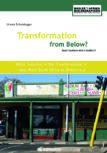Transformation from Below? White Suburbia in the Transformation of Apartheid South Africa to Democracy
- Language: Englisch
- 158 pages
- Illustrations, tables, index
- Vol. 9
- ISSN: 2296-6986
- ISBN:
- Print: 978-3-905758-58-0
- PDF: 978-3-905758-71-9
Transformation from Below? White Suburbia in the Transformation of Apartheid South Africa to Democracy
South Africa is an example of a relatively successful political transition. Nevertheless, the first democratic elections in 1994 did not change the systemic and structural inequalities, the socio-economic legacies of discrimination or the alienation of the different population groups. At the centre of this study is the transformation potential of two formerly white neighbourhoods in Johannesburg – Norwood and Orange Grove. Both neighbourhoods have experienced considerable demographic changes and the various population groups differ in terms of their expectations and their willingness to adjust to the changes provoked by the transition. At the local level, patterns of discrimination and oppression continue. Spaces, opportunities and leverage of social networks engaged in the community are influenced by the resources people are able to access. Moreover, cooperation is contested in a context of pervasive inequality because there is no incentive for privileged groups to change arrangements that benefit them. In this context of conflicting interests and unequal access to power and resources, decentralisation and the promotion of participatory structures in local communities are a problem and the reliance on local networks as agents of development is questionable.
Ursula Scheidegger has a PhD in Political Studies. She is a researcher at the University of the Witwatersrand in Johannesburg, working on democracy, participation and representation, social dynamics, power and contestation and questions of values and interests. She is also a consultant to different non-governmental organisations.
Social Dynamics in Two Formerly White Johannesburg Neighbourhoods. An Introduction
1 Social Dynamics and the Concept of Social Capital
2 The Challenges of Democratic Consolidation in South Africa
3 Urban Neighbourhoods and Challenges of Cooperation and Order
4 Local Communities and the Ambiguity of Transformation
5 Local Schools and their Impact on Integration, Civic Engagement and Neighbourhood Sociability
6 Religious Communities and Responses to the Challenges of Transformation, Value Changes and Inequality
7 Five Years Later – What Has Changed?
8 Conclusion – Transformation from Below?
Appendix
“A significant contribution to our understanding of how different ‘communities’ at local level have reconfigured their relationships and social, political and economic interests in South Africa since 1994. … Focusing on civil society institutions, schools and religious institutions, the author is able to access the potential for the development of new forms of social capital, and shows just how difficult this is in the context of the legacies of apartheid racialised spatial and social arrangements. She shows how race continues to trump class and that organisations tend to reflect ‘old order’ arrangements of exclusion, but these are highly contested.”
Sheila Meintjes, University of the Witwatersrand

